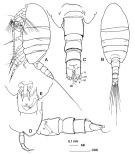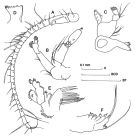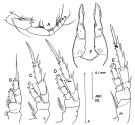|
|
 |
|
Calanoida ( Order ) |
|
|
|
Clausocalanoidea ( Superfamily ) |
|
|
|
Stephidae ( Family ) |
|
|
|
Stephos ( Genus ) |
|
|
| |
Stephos hastatus Bradford-Grieve, 1999 (F,M) | |
| | | | | | | Ref.: | | | Bradford-Grieve, 1999 a (p.15, figs.F,M, Table 1); S.Y. Moon & al., 2015 (p.33: Rem.) |  issued from : J.M. Bradford-Grieve in N.Z. Jl mar. freshw. Res., 1999, 33. [p.16, Fig.1]. Female (Wellington Harbour, New Zealand): A, habitus (lateral left side); B, idem (dorsal); C, urosome (dorsal); D, idem (lateral left side); E, genital double-somite (ventral).
|
 issued from : J.M. Bradford-Grieve in N.Z. Jl mar. freshw. Res., 1999, 33. [p.17, Fig.2]. Female: A, A1; B, A2; C, Md; D, Md (mandibular gnathobase); E, Mx1; F, Mx2. Nota: Mx1 praecoxal arthrite with 9 terminal spines and 4 posterior surface setae; coxal endite and basal endites 1 and 2 with 3, 4, 5 setae respectively; basis and endopod fused, endopod with 4+5+7 setae; exopod with 11 setae and a row of small surface spinules; coxal epipodite with 9 setae ; basal exite without setae.
|
 issued from : J.M. Bradford-Grieve in N.Z. Jl mar. freshw. Res., 1999, 33. [p.18, Fig.3]. Female: A, Mxp; B, P1 (posterior view); C, P2 (anterior view); D, P3 (anterior view); E, P4 (posterior view); F, P5 (posterior view). Nota: P5 uniramous, symmetrical, coxae fused to the intercoxal sclerite, basis separated from the single, tapering, terminal segment. Segment 2 (basis) with inner proximal patch of very fine spinules on anterior surface, and a distinct pore on inner border at about mid-length. Segment 3 constricted slightly at about mid-length and with striated hyaline fringe around the terminal tapering part of the segment; a fine outer edge seta is inserted at the constriction; a distinct anterior surface pore is found on the proximal half of segment 3; there are 2 patches of spinules: one patch is located at level of the pore on the posterior surface, the second row is on the anterior surface curving from the inner surface distally to the constriction.
|
 issued from : J.M. Bradford-Grieve in N.Z. Jl mar. freshw. Res., 1999, 33. [p.19, Fig.4]. Male: A, habitus (dorsal); B, idem (dorso-lateral right side); C, urosome (lateral right side); D, P5 (L = left; R = right). Nota: A swollen left P5 segment 4. Nota: Cephalosome incompletely separated from pediger , pedigers 4 and 5 fused alyjough the fusion line is visible mid-dorsally. - P5 very asymmetrical, slender on the right and large and developed as a grasping organ on the left. Right leg 4-segmented; coxa about twice as long as the basis, unarmede; segment 3 elongate, unarmed, but with 1 triangular proximal process and 2 distal processes (distal-most rounded terminally and directed posteriorly, the other triangular and directed anteriorly); segment 4 comprising 2 processes set at right angles, distally-directed branch tapering, outwardly-directed branch curved distally and rounded at its tip. Left leg 5-segmented; coxa and basis of similar length to that on the right side, unarmed; segment 3 short, unarmed, almost fused with segment 4; segment 4 robust, with a short strong spine on the anterior distal surface and a very long stout spine inserted at the distal inner corner of the segment and almost as long as its segment; segment 5 complex, with 2 elongate, leaf-like appendages.
| | | | | NZ: | 1 | | |
|
Distribution map of Stephos hastatus by geographical zones
|
| | | | Loc: | | | New Zealand (Wellinton Harbour: Evans Bay) | | | | N: | 1 | | | | Lg.: | | | (774) F: 1,09-0,92; M: 1,02-0,85; {F: 0,92-1,09; M: 0,85-1,02} | | | | Rem.: | In 12 m of water in Evans Bay.
According to Bradford-Grieve (1999 a, p.19) this species is similar to S. pacificus and S. robustus. There is a small amount of variation in the numbers of spinules on the genital double-somite and on the surfaces of the swimming legs.
After Bradford-Grieve (1999 a, p.25) this species belongs to type III (see Genus Stephos). | | | Last update : 22/01/2016 | |
|
|
 Any use of this site for a publication will be mentioned with the following reference : Any use of this site for a publication will be mentioned with the following reference :
Razouls C., Desreumaux N., Kouwenberg J. and de Bovée F., 2005-2025. - Biodiversity of Marine Planktonic Copepods (morphology, geographical distribution and biological data). Sorbonne University, CNRS. Available at http://copepodes.obs-banyuls.fr/en [Accessed December 02, 2025] © copyright 2005-2025 Sorbonne University, CNRS
|
|
 |
 |







